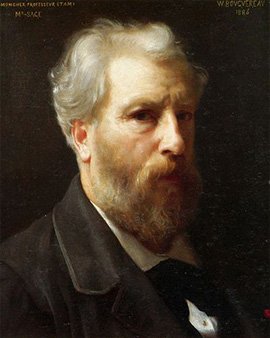William-Adolphe Bouguereau was born as the eldest son of a wine and olive oil producer in La Rochelle. At the age of 12, the family sent him to his uncle, a priest, in Mortagne. Influenced by his uncle, the young Bouguereau developed a passion for nature, religion and literature. At the age of 14, he began his priestly studies in Pons. There he was taught painting and drawing by Louis Sage, a former student of Ingres. Bouguereau had to break off his studies prematurely and move to his family in Bordeaux. He continued his education there and enrolled at the municipal art school in 1841. After only a short time he became the best student in his class. In Bouguereau the desire to work as a painter in Paris developed. He financed his move within 3 months by himself. He produced and sold a total of 33 oil portraits. At the age of 20 he moved to Paris and attended the École des Beaux-Arts. He did not limit his education to art, but attended anatomical dissections, studied historical costumes and archaeology.
Bourguerau was able to get a place in the studio of Francois-Edouard Picot after his studies. Picot introduced him to painting in the academic style. After three attempts he finally won the coveted Prix de Rome in 1850. The winners of the prize were allowed to travel to Rome. In total he spent almost four years in Italy before returning to Paris in 1854. Bourgueau was revered as a master of academic classicism and realism. During his entire active creative period he was allowed to exhibit every year in the Paris Salon. His works like "The Birth of Venus" earned him much recognition and he soon became internationally known. Art critics of his time liked to compare him with Raphael. Bourgureau held Raphael in high esteem and liked to base his paintings on Renaissance painters like Tiziano Vecelli. He thus stood in sharp contrast to Impressionism and other experimental art movements.
Bourguereau was closely associated with the Académie Julien, where he taught students from all over the world. Among his students was Henri Matisse. As far as is known, Bourguereau is said to have produced a total of over 822 paintings. The majority, however, is considered lost. Bourguereau was an extremely zealous painter who once described his relationship to his work as follows: "Every day I go to my studio full of joy. In the evening, when I have to stop because of the darkness, I can't wait for the next morning." He died at 79 of heart disease in his hometown of La Rochelle.
×





.jpg)
.jpg)
.jpg)
.jpg)
.jpg)
.jpg)
.jpg)
.jpg)
.jpg)
.jpg)
.jpg)
.jpg)
.jpg)
.jpg)
.jpg)
.jpg)


.jpg)
.jpg)
.jpg)
.jpg)
.jpg)
.jpg)
.jpg)
.jpg)
.jpg)
.jpg)
.jpg)
.jpg)
.jpg)
.jpg)
.jpg)
.jpg)
.jpg)
.jpg)
.jpg)
.jpg)
.jpg)
.jpg)
.jpg)
.jpg)
.jpg)
.jpg)
.jpg)
.jpg)
.jpg)
.jpg)
.jpg)
.jpg)
.jpg)
.jpg)
 - (MeisterDrucke-27819).jpg)
 - (MeisterDrucke-27819).jpg)
.jpg)
.jpg)
.jpg)
.jpg)
.jpg)
.jpg)
.jpg)
.jpg)
 - (MeisterDrucke-2471).jpg)
 - (MeisterDrucke-2471).jpg)
.jpg)
.jpg)
.jpg)
.jpg)
.jpg)
.jpg)
.jpg)
.jpg)
.jpg)
.jpg)
_-_(MeisterDrucke-27662).jpg)
_-_(MeisterDrucke-27662).jpg)
.jpg)
.jpg)
.jpg)
.jpg)
.jpg)
.jpg)
.jpg)
.jpg)
.jpg)
.jpg)
.jpg)
.jpg)
.jpg)
.jpg)
.jpg)
.jpg)
.jpg)
.jpg)
.jpg)
.jpg)
_1900_-_(MeisterDrucke-951090).jpg)
_1900_-_(MeisterDrucke-951090).jpg)
.jpg)
.jpg)
.jpg)
.jpg)
.jpg)
.jpg)
.jpg)
.jpg)
.jpg)
.jpg)
.jpg)
.jpg)
.jpg)
.jpg)
.jpg)
.jpg)
.jpg)
.jpg)
.jpg)
.jpg)
.jpg)
.jpg)
.jpg)
.jpg)
.jpg)
.jpg)
_-_(MeisterDrucke-1323887).jpg)
_-_(MeisterDrucke-1323887).jpg)
 - (MeisterDrucke-27799).jpg)
 - (MeisterDrucke-27799).jpg)
.jpg)
.jpg)
.jpg)
.jpg)
.jpg)
.jpg)
.jpg)
.jpg)
.jpg)
.jpg)
.jpg)
.jpg)
.jpg)
.jpg)
_-_(MeisterDrucke-144287).jpg)
_-_(MeisterDrucke-144287).jpg)
.jpg)
.jpg)
.jpg)
.jpg)
.jpg)
.jpg)
.jpg)
.jpg)
.jpg)
.jpg)
.jpg)
.jpg)
.jpg)
.jpg)
.jpg)
.jpg)
.jpg)
.jpg)
.jpg)
.jpg)
.jpg)
.jpg)
.jpg)
.jpg)
.jpg)
.jpg)
.jpg)
.jpg)
.jpg)
.jpg)
.jpg)
.jpg)
.jpg)
.jpg)
.jpg)
.jpg)
.jpg)
.jpg)
.jpg)
.jpg)
.jpg)
.jpg)
.jpg)
.jpg)
.jpg)
.jpg)
.jpg)
.jpg)
.jpg)
.jpg)
.jpg)
.jpg)
.jpg)
.jpg)
.jpg)
.jpg)






